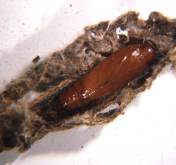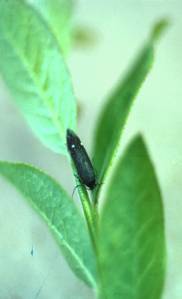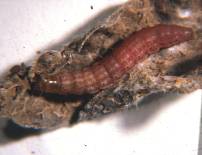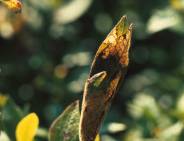205-Red-Striped Fireworm (Aroga trialbamaculella Cham.)
Fact Sheet No. 205, UMaine Extension No. 2284
Prepared by Judith A. Collins, Assistant Scientist, and H. Y. Forsythe, Jr., Professor of Entomology, in cooperation with David Yarborough, Extension Blueberry Specialist, The University of Maine, Orono ME, 04469. February 1994.
Description
Young caterpillar-like larvae have a greenish body with darker heads. As they grow, faint reddish lines running the length of the body appear on the back and sides. The red color becomes more pronounced as they mature.
Fully grown larvae are about 3/8 inch long and very active when disturbed. They are found feeding between leaves which they have tied together with strands of silk. Pupae are found in the litter and are small and reddish brown (Figure 1).
Adult moths are small (about ½ inch long), slender, dark brown or black with a white face and white spots on their forewings and legs (Figure 2). Adults are agile fliers and difficult to detect.
- Photo 1: Pupa
- Photo 2: Adult
- Photo 3: Larva
- Photo 4: Damage
- Photo 5: Damage
Life Cycle
The red-striped fireworm spends the winter as fully grown larvae in old, dead, curled blueberry leaves in the ground litter (Figure 3). At this stage and time they do not feed but transform to pupae in late April and early May, after which, the new adults begin to emerge in one to two weeks. Adults can first be seen in the field in mid-May and are present until early August; peak numbers usually occur in July. Eggs are laid on blueberry plants, and larvae hatch and begin webbing together leaves and feeding in early to mid-July. Initially, only one or two leaves may be webbed together with strands of silk (Figure 4); however, as the larvae increase in size, more leaves are webbed together on the stems to provide shelter and food. In heavily infested fields, over 50 percent of the blueberry stems may be webbed together (Figure 5). During September, larvae move into the ground litter where they spend the winter.
Damage and Economic Importance
Although it has been reported that red-striped fireworm larvae reduce numbers of fruit buds, this has not yet been verified in Maine. Currently, the major concern of larval fireworm infestations is their appearance on field machinery and processing lines during harvest. Larvae are apparently jarred from the protective leaf areas during raking and collected mechanically. Larvae are also dislodged or blown with debris from winnowing machines and reinfest blueberry stems immediately adjacent to the equipment; this provides an important center of reinfestation the following year. Larvae are present in the field from July through September. The later in the season leaf-tying activity occurs, the less likely larvae are to be a problem.
Pest Management
For information regarding monitoring and control, contact the lowbush blueberry specialist, University of Maine Cooperative Extension, 1.800.897.0757 (toll-free in Maine) or 207.581.2923.
Information in this publication is provided purely for educational purposes. No responsibility is assumed for any problems associated with the use of products or services mentioned. No endorsement of products or companies is intended, nor is criticism of unnamed products or companies implied.
© 1994
Call 800.287.0274 (in Maine), or 207.581.3188, for information on publications and program offerings from University of Maine Cooperative Extension, or visit extension.umaine.edu.
The University of Maine is an EEO/AA employer, and does not discriminate on the grounds of race, color, religion, sex, sexual orientation, transgender status, gender expression, national origin, citizenship status, age, disability, genetic information or veteran’s status in employment, education, and all other programs and activities. The following person has been designated to handle inquiries regarding non-discrimination policies: Director of Equal Opportunity, 101 Boudreau Hall, University of Maine, Orono, ME 04469-5754, 207.581.1226, TTY 711 (Maine Relay System).





